Light Rail in Manchester City: Design and Development Report
VerifiedAdded on 2020/04/01
|14
|3645
|30
Report
AI Summary
This report provides a comprehensive overview of a light rail transit (LRT) project in Manchester, focusing on the design, development, and testing phases. It begins with an executive summary highlighting the importance of modern transport solutions in rapidly growing cities and the benefits of LRT, including reduced traffic congestion, environmental improvements, and enhanced economic development. The report delves into the preliminary design phase, emphasizing the identification of key components such as route, lanes, and power systems, along with the allocation of resources and adherence to design criteria. It then explores the detailed design and development phases, including the use of CAD software, field studies, and the creation of mock-ups and prototypes. The report further discusses the critical processes of system testing, evaluation, validation, and optimization, highlighting the importance of testing individual components and the entire system to ensure project requirements are met. Finally, the report addresses human factors, including anthropometric, sensory, and physiological considerations, which are vital for the project's success. The report concludes with recommendations for effective implementation, emphasizing the need for teamwork, stakeholder collaboration, and adherence to best practices throughout the project lifecycle.
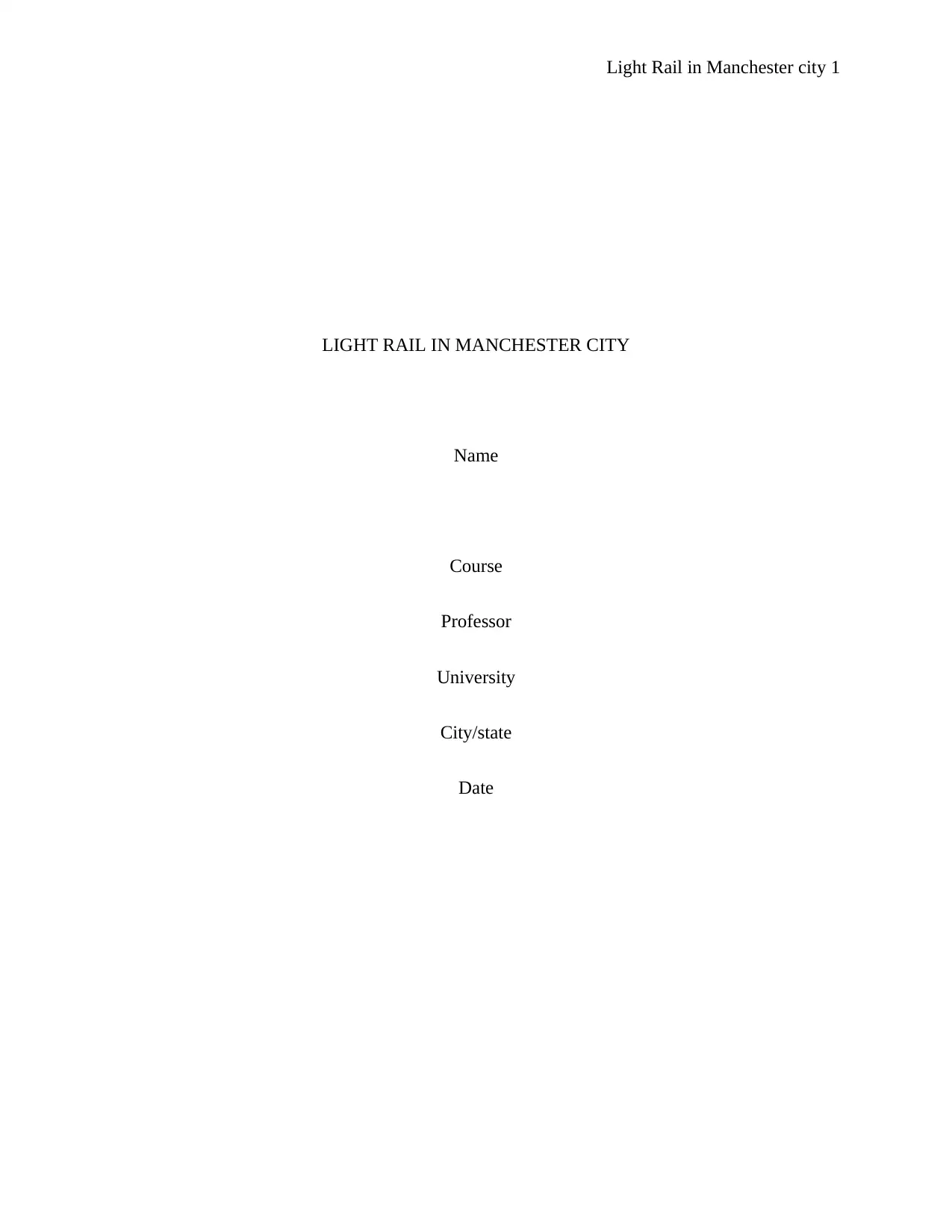
Light Rail in Manchester city 1
LIGHT RAIL IN MANCHESTER CITY
Name
Course
Professor
University
City/state
Date
LIGHT RAIL IN MANCHESTER CITY
Name
Course
Professor
University
City/state
Date
Paraphrase This Document
Need a fresh take? Get an instant paraphrase of this document with our AI Paraphraser
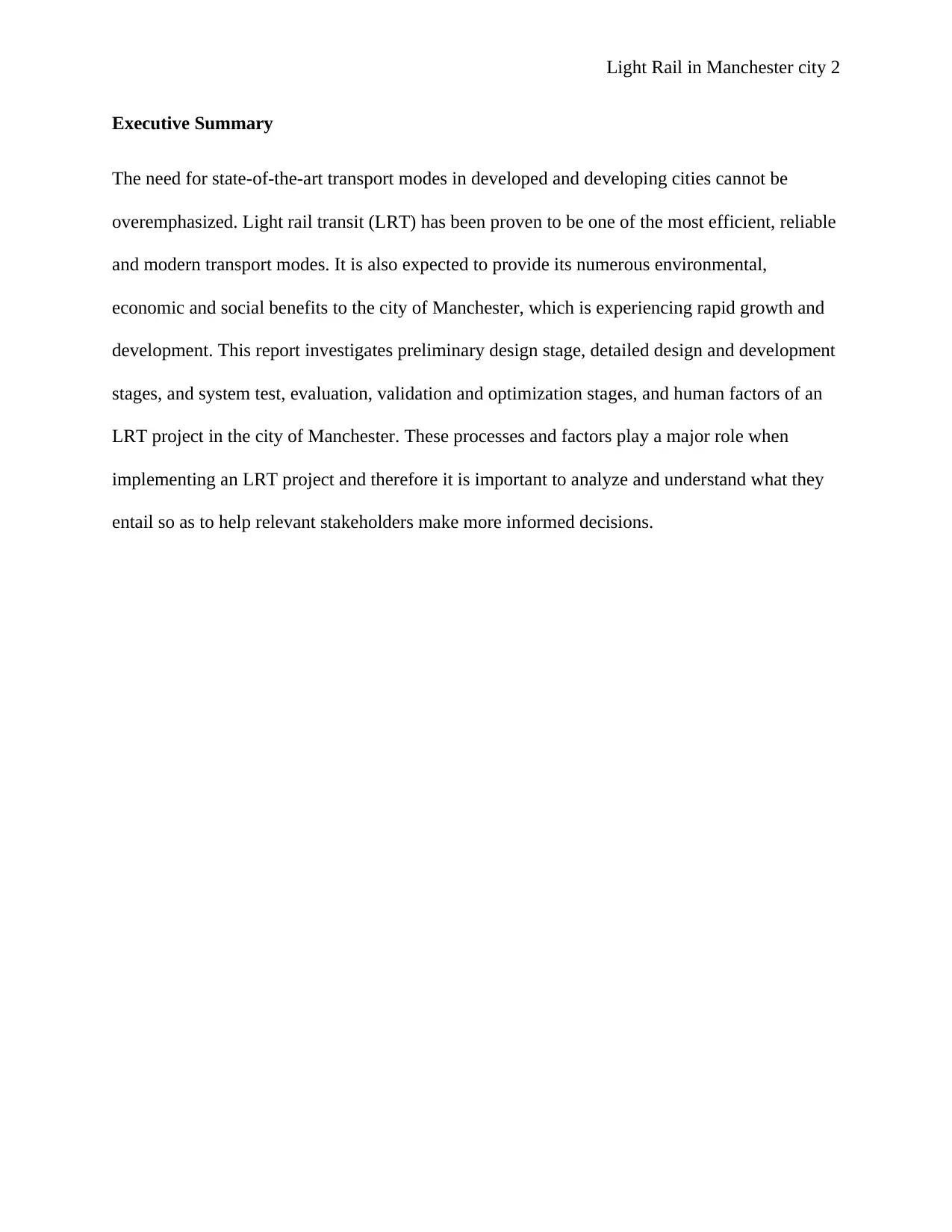
Light Rail in Manchester city 2
Executive Summary
The need for state-of-the-art transport modes in developed and developing cities cannot be
overemphasized. Light rail transit (LRT) has been proven to be one of the most efficient, reliable
and modern transport modes. It is also expected to provide its numerous environmental,
economic and social benefits to the city of Manchester, which is experiencing rapid growth and
development. This report investigates preliminary design stage, detailed design and development
stages, and system test, evaluation, validation and optimization stages, and human factors of an
LRT project in the city of Manchester. These processes and factors play a major role when
implementing an LRT project and therefore it is important to analyze and understand what they
entail so as to help relevant stakeholders make more informed decisions.
Executive Summary
The need for state-of-the-art transport modes in developed and developing cities cannot be
overemphasized. Light rail transit (LRT) has been proven to be one of the most efficient, reliable
and modern transport modes. It is also expected to provide its numerous environmental,
economic and social benefits to the city of Manchester, which is experiencing rapid growth and
development. This report investigates preliminary design stage, detailed design and development
stages, and system test, evaluation, validation and optimization stages, and human factors of an
LRT project in the city of Manchester. These processes and factors play a major role when
implementing an LRT project and therefore it is important to analyze and understand what they
entail so as to help relevant stakeholders make more informed decisions.
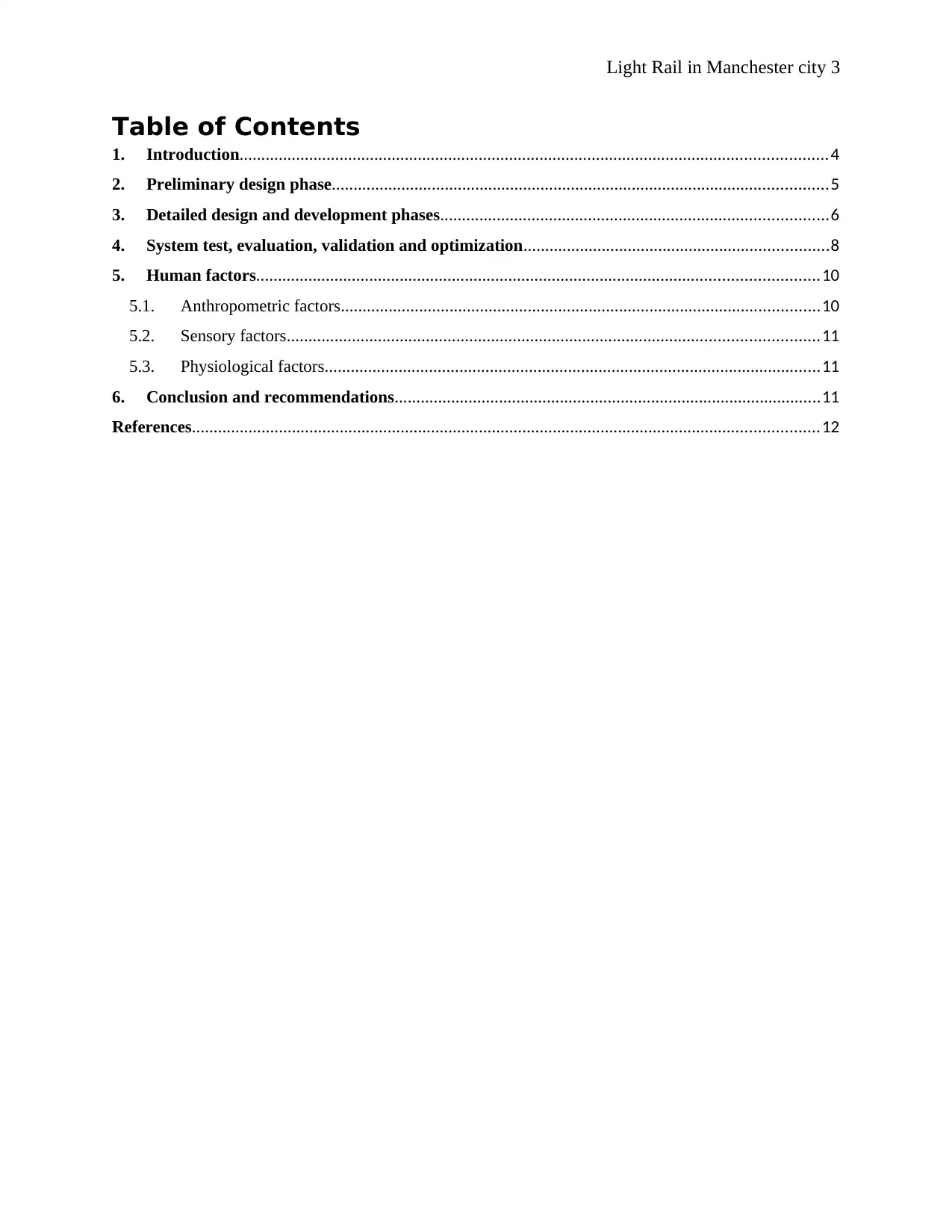
Light Rail in Manchester city 3
Table of Contents
1. Introduction.......................................................................................................................................4
2. Preliminary design phase..................................................................................................................5
3. Detailed design and development phases.........................................................................................6
4. System test, evaluation, validation and optimization......................................................................8
5. Human factors.................................................................................................................................10
5.1. Anthropometric factors..............................................................................................................10
5.2. Sensory factors..........................................................................................................................11
5.3. Physiological factors..................................................................................................................11
6. Conclusion and recommendations..................................................................................................11
References................................................................................................................................................12
Table of Contents
1. Introduction.......................................................................................................................................4
2. Preliminary design phase..................................................................................................................5
3. Detailed design and development phases.........................................................................................6
4. System test, evaluation, validation and optimization......................................................................8
5. Human factors.................................................................................................................................10
5.1. Anthropometric factors..............................................................................................................10
5.2. Sensory factors..........................................................................................................................11
5.3. Physiological factors..................................................................................................................11
6. Conclusion and recommendations..................................................................................................11
References................................................................................................................................................12
⊘ This is a preview!⊘
Do you want full access?
Subscribe today to unlock all pages.

Trusted by 1+ million students worldwide
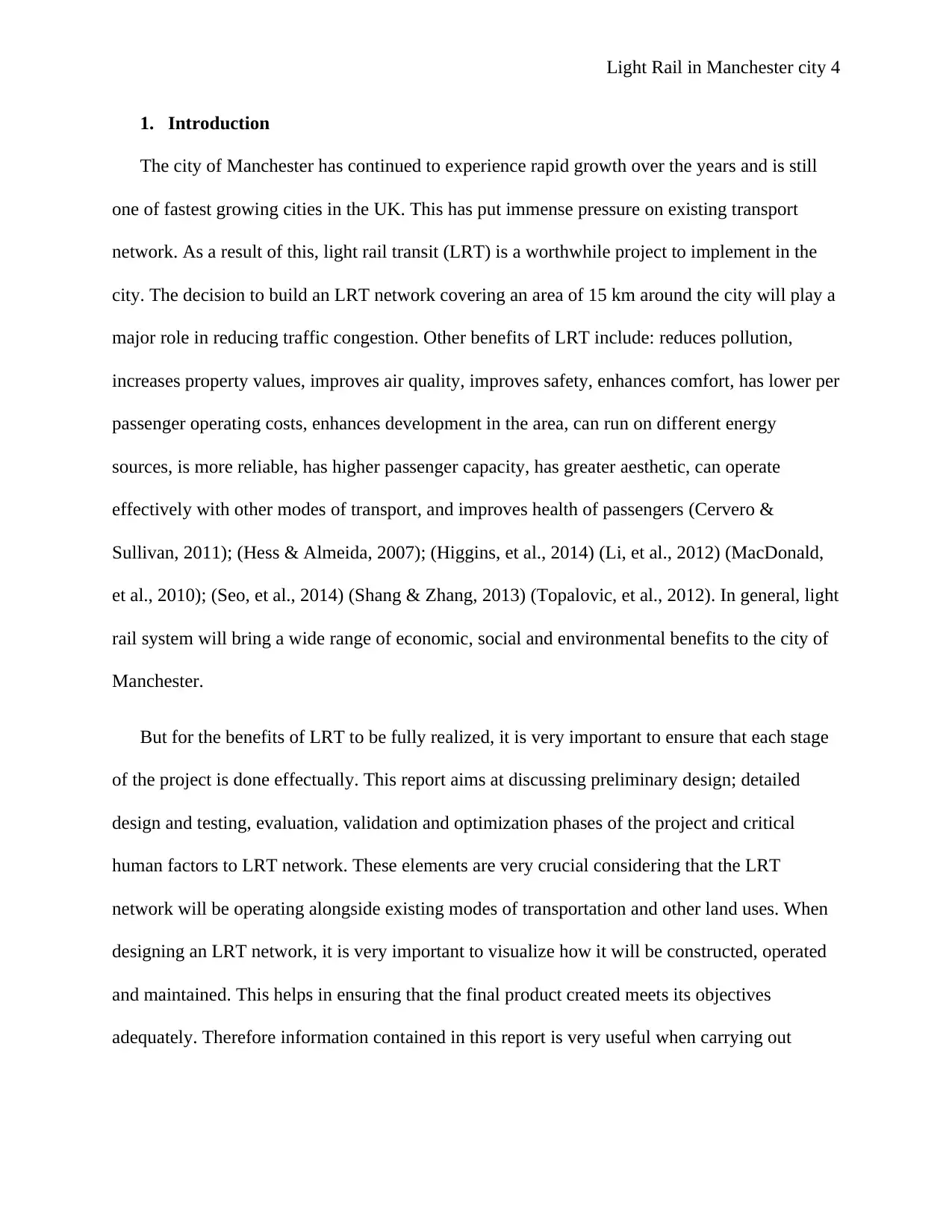
Light Rail in Manchester city 4
1. Introduction
The city of Manchester has continued to experience rapid growth over the years and is still
one of fastest growing cities in the UK. This has put immense pressure on existing transport
network. As a result of this, light rail transit (LRT) is a worthwhile project to implement in the
city. The decision to build an LRT network covering an area of 15 km around the city will play a
major role in reducing traffic congestion. Other benefits of LRT include: reduces pollution,
increases property values, improves air quality, improves safety, enhances comfort, has lower per
passenger operating costs, enhances development in the area, can run on different energy
sources, is more reliable, has higher passenger capacity, has greater aesthetic, can operate
effectively with other modes of transport, and improves health of passengers (Cervero &
Sullivan, 2011); (Hess & Almeida, 2007); (Higgins, et al., 2014) (Li, et al., 2012) (MacDonald,
et al., 2010); (Seo, et al., 2014) (Shang & Zhang, 2013) (Topalovic, et al., 2012). In general, light
rail system will bring a wide range of economic, social and environmental benefits to the city of
Manchester.
But for the benefits of LRT to be fully realized, it is very important to ensure that each stage
of the project is done effectually. This report aims at discussing preliminary design; detailed
design and testing, evaluation, validation and optimization phases of the project and critical
human factors to LRT network. These elements are very crucial considering that the LRT
network will be operating alongside existing modes of transportation and other land uses. When
designing an LRT network, it is very important to visualize how it will be constructed, operated
and maintained. This helps in ensuring that the final product created meets its objectives
adequately. Therefore information contained in this report is very useful when carrying out
1. Introduction
The city of Manchester has continued to experience rapid growth over the years and is still
one of fastest growing cities in the UK. This has put immense pressure on existing transport
network. As a result of this, light rail transit (LRT) is a worthwhile project to implement in the
city. The decision to build an LRT network covering an area of 15 km around the city will play a
major role in reducing traffic congestion. Other benefits of LRT include: reduces pollution,
increases property values, improves air quality, improves safety, enhances comfort, has lower per
passenger operating costs, enhances development in the area, can run on different energy
sources, is more reliable, has higher passenger capacity, has greater aesthetic, can operate
effectively with other modes of transport, and improves health of passengers (Cervero &
Sullivan, 2011); (Hess & Almeida, 2007); (Higgins, et al., 2014) (Li, et al., 2012) (MacDonald,
et al., 2010); (Seo, et al., 2014) (Shang & Zhang, 2013) (Topalovic, et al., 2012). In general, light
rail system will bring a wide range of economic, social and environmental benefits to the city of
Manchester.
But for the benefits of LRT to be fully realized, it is very important to ensure that each stage
of the project is done effectually. This report aims at discussing preliminary design; detailed
design and testing, evaluation, validation and optimization phases of the project and critical
human factors to LRT network. These elements are very crucial considering that the LRT
network will be operating alongside existing modes of transportation and other land uses. When
designing an LRT network, it is very important to visualize how it will be constructed, operated
and maintained. This helps in ensuring that the final product created meets its objectives
adequately. Therefore information contained in this report is very useful when carrying out
Paraphrase This Document
Need a fresh take? Get an instant paraphrase of this document with our AI Paraphraser
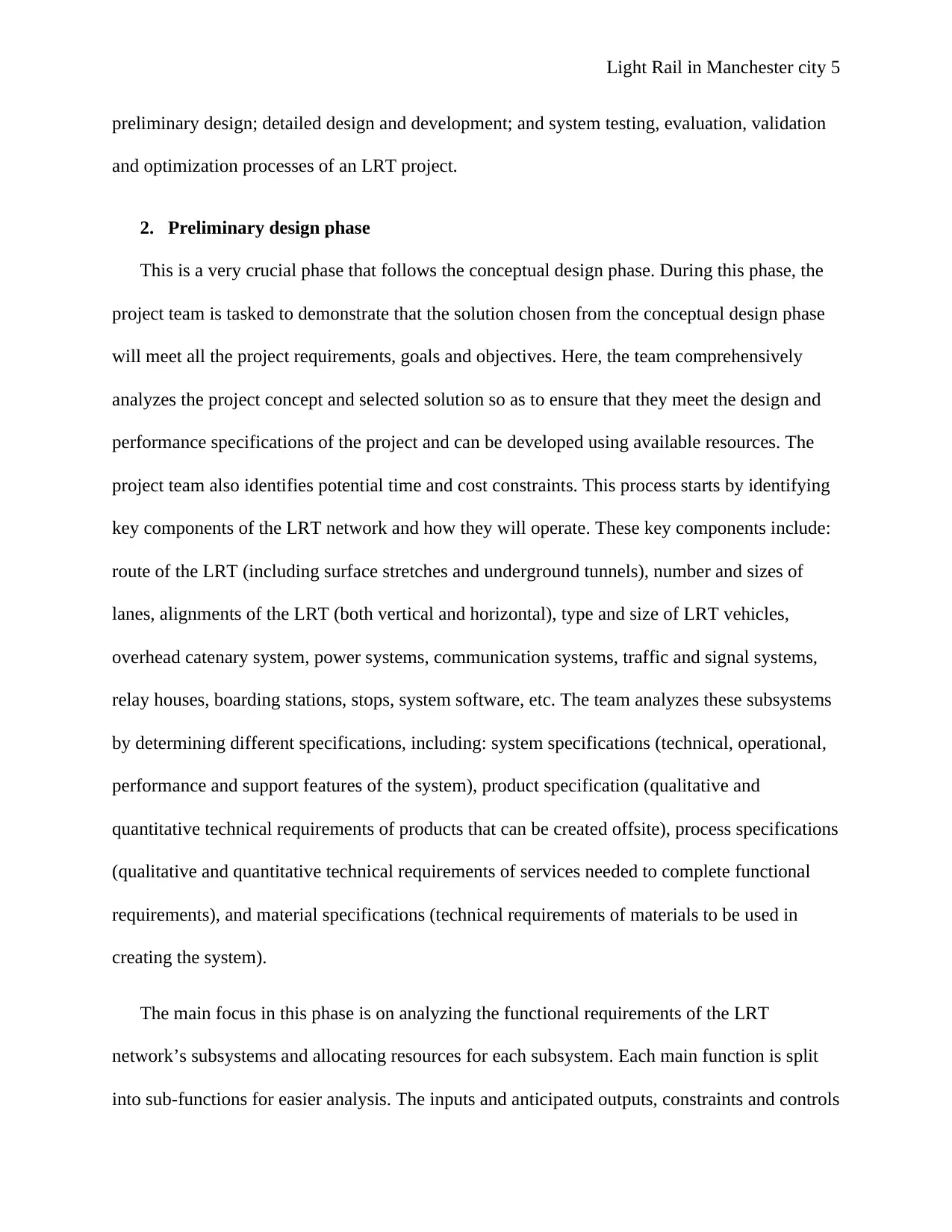
Light Rail in Manchester city 5
preliminary design; detailed design and development; and system testing, evaluation, validation
and optimization processes of an LRT project.
2. Preliminary design phase
This is a very crucial phase that follows the conceptual design phase. During this phase, the
project team is tasked to demonstrate that the solution chosen from the conceptual design phase
will meet all the project requirements, goals and objectives. Here, the team comprehensively
analyzes the project concept and selected solution so as to ensure that they meet the design and
performance specifications of the project and can be developed using available resources. The
project team also identifies potential time and cost constraints. This process starts by identifying
key components of the LRT network and how they will operate. These key components include:
route of the LRT (including surface stretches and underground tunnels), number and sizes of
lanes, alignments of the LRT (both vertical and horizontal), type and size of LRT vehicles,
overhead catenary system, power systems, communication systems, traffic and signal systems,
relay houses, boarding stations, stops, system software, etc. The team analyzes these subsystems
by determining different specifications, including: system specifications (technical, operational,
performance and support features of the system), product specification (qualitative and
quantitative technical requirements of products that can be created offsite), process specifications
(qualitative and quantitative technical requirements of services needed to complete functional
requirements), and material specifications (technical requirements of materials to be used in
creating the system).
The main focus in this phase is on analyzing the functional requirements of the LRT
network’s subsystems and allocating resources for each subsystem. Each main function is split
into sub-functions for easier analysis. The inputs and anticipated outputs, constraints and controls
preliminary design; detailed design and development; and system testing, evaluation, validation
and optimization processes of an LRT project.
2. Preliminary design phase
This is a very crucial phase that follows the conceptual design phase. During this phase, the
project team is tasked to demonstrate that the solution chosen from the conceptual design phase
will meet all the project requirements, goals and objectives. Here, the team comprehensively
analyzes the project concept and selected solution so as to ensure that they meet the design and
performance specifications of the project and can be developed using available resources. The
project team also identifies potential time and cost constraints. This process starts by identifying
key components of the LRT network and how they will operate. These key components include:
route of the LRT (including surface stretches and underground tunnels), number and sizes of
lanes, alignments of the LRT (both vertical and horizontal), type and size of LRT vehicles,
overhead catenary system, power systems, communication systems, traffic and signal systems,
relay houses, boarding stations, stops, system software, etc. The team analyzes these subsystems
by determining different specifications, including: system specifications (technical, operational,
performance and support features of the system), product specification (qualitative and
quantitative technical requirements of products that can be created offsite), process specifications
(qualitative and quantitative technical requirements of services needed to complete functional
requirements), and material specifications (technical requirements of materials to be used in
creating the system).
The main focus in this phase is on analyzing the functional requirements of the LRT
network’s subsystems and allocating resources for each subsystem. Each main function is split
into sub-functions for easier analysis. The inputs and anticipated outputs, constraints and controls
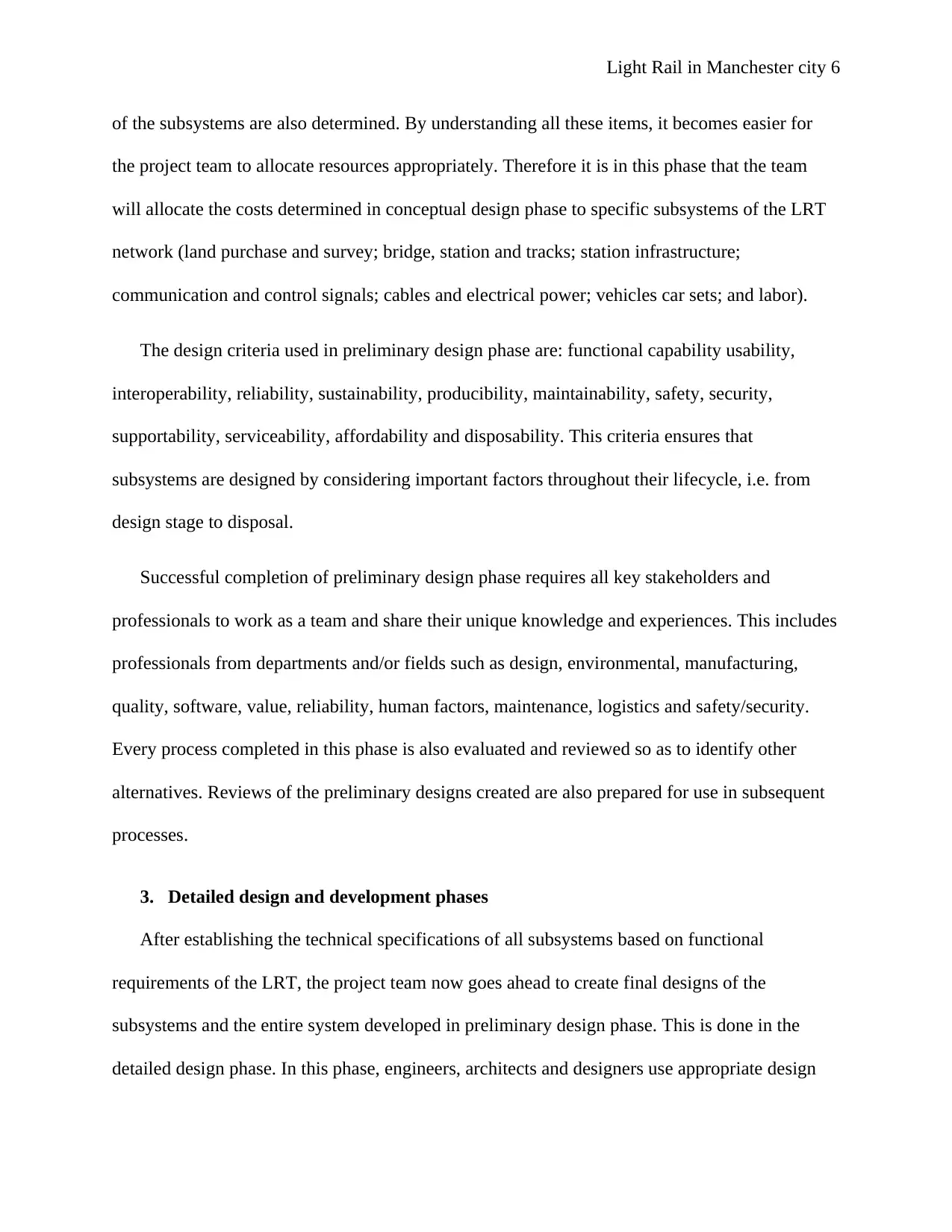
Light Rail in Manchester city 6
of the subsystems are also determined. By understanding all these items, it becomes easier for
the project team to allocate resources appropriately. Therefore it is in this phase that the team
will allocate the costs determined in conceptual design phase to specific subsystems of the LRT
network (land purchase and survey; bridge, station and tracks; station infrastructure;
communication and control signals; cables and electrical power; vehicles car sets; and labor).
The design criteria used in preliminary design phase are: functional capability usability,
interoperability, reliability, sustainability, producibility, maintainability, safety, security,
supportability, serviceability, affordability and disposability. This criteria ensures that
subsystems are designed by considering important factors throughout their lifecycle, i.e. from
design stage to disposal.
Successful completion of preliminary design phase requires all key stakeholders and
professionals to work as a team and share their unique knowledge and experiences. This includes
professionals from departments and/or fields such as design, environmental, manufacturing,
quality, software, value, reliability, human factors, maintenance, logistics and safety/security.
Every process completed in this phase is also evaluated and reviewed so as to identify other
alternatives. Reviews of the preliminary designs created are also prepared for use in subsequent
processes.
3. Detailed design and development phases
After establishing the technical specifications of all subsystems based on functional
requirements of the LRT, the project team now goes ahead to create final designs of the
subsystems and the entire system developed in preliminary design phase. This is done in the
detailed design phase. In this phase, engineers, architects and designers use appropriate design
of the subsystems are also determined. By understanding all these items, it becomes easier for
the project team to allocate resources appropriately. Therefore it is in this phase that the team
will allocate the costs determined in conceptual design phase to specific subsystems of the LRT
network (land purchase and survey; bridge, station and tracks; station infrastructure;
communication and control signals; cables and electrical power; vehicles car sets; and labor).
The design criteria used in preliminary design phase are: functional capability usability,
interoperability, reliability, sustainability, producibility, maintainability, safety, security,
supportability, serviceability, affordability and disposability. This criteria ensures that
subsystems are designed by considering important factors throughout their lifecycle, i.e. from
design stage to disposal.
Successful completion of preliminary design phase requires all key stakeholders and
professionals to work as a team and share their unique knowledge and experiences. This includes
professionals from departments and/or fields such as design, environmental, manufacturing,
quality, software, value, reliability, human factors, maintenance, logistics and safety/security.
Every process completed in this phase is also evaluated and reviewed so as to identify other
alternatives. Reviews of the preliminary designs created are also prepared for use in subsequent
processes.
3. Detailed design and development phases
After establishing the technical specifications of all subsystems based on functional
requirements of the LRT, the project team now goes ahead to create final designs of the
subsystems and the entire system developed in preliminary design phase. This is done in the
detailed design phase. In this phase, engineers, architects and designers use appropriate design
⊘ This is a preview!⊘
Do you want full access?
Subscribe today to unlock all pages.

Trusted by 1+ million students worldwide
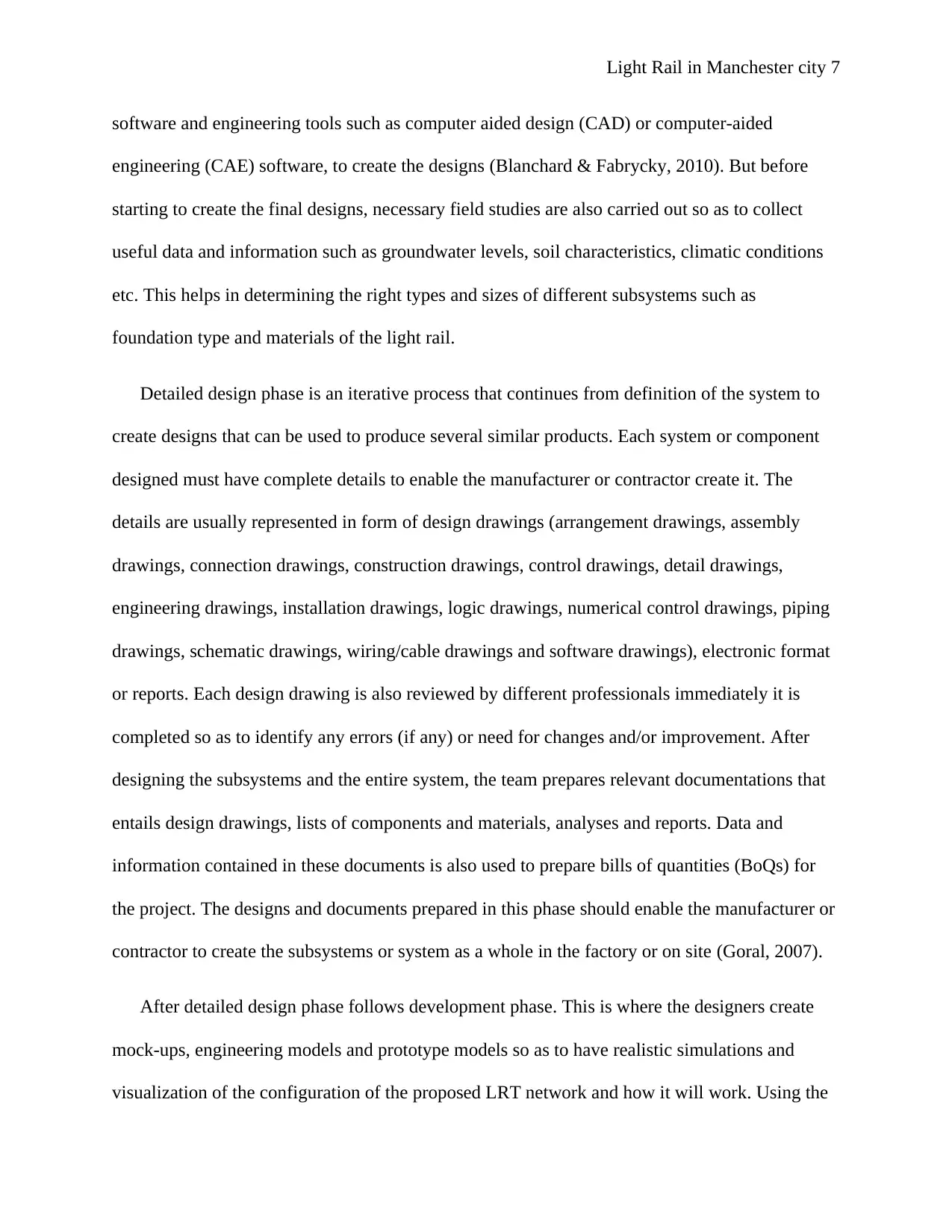
Light Rail in Manchester city 7
software and engineering tools such as computer aided design (CAD) or computer-aided
engineering (CAE) software, to create the designs (Blanchard & Fabrycky, 2010). But before
starting to create the final designs, necessary field studies are also carried out so as to collect
useful data and information such as groundwater levels, soil characteristics, climatic conditions
etc. This helps in determining the right types and sizes of different subsystems such as
foundation type and materials of the light rail.
Detailed design phase is an iterative process that continues from definition of the system to
create designs that can be used to produce several similar products. Each system or component
designed must have complete details to enable the manufacturer or contractor create it. The
details are usually represented in form of design drawings (arrangement drawings, assembly
drawings, connection drawings, construction drawings, control drawings, detail drawings,
engineering drawings, installation drawings, logic drawings, numerical control drawings, piping
drawings, schematic drawings, wiring/cable drawings and software drawings), electronic format
or reports. Each design drawing is also reviewed by different professionals immediately it is
completed so as to identify any errors (if any) or need for changes and/or improvement. After
designing the subsystems and the entire system, the team prepares relevant documentations that
entails design drawings, lists of components and materials, analyses and reports. Data and
information contained in these documents is also used to prepare bills of quantities (BoQs) for
the project. The designs and documents prepared in this phase should enable the manufacturer or
contractor to create the subsystems or system as a whole in the factory or on site (Goral, 2007).
After detailed design phase follows development phase. This is where the designers create
mock-ups, engineering models and prototype models so as to have realistic simulations and
visualization of the configuration of the proposed LRT network and how it will work. Using the
software and engineering tools such as computer aided design (CAD) or computer-aided
engineering (CAE) software, to create the designs (Blanchard & Fabrycky, 2010). But before
starting to create the final designs, necessary field studies are also carried out so as to collect
useful data and information such as groundwater levels, soil characteristics, climatic conditions
etc. This helps in determining the right types and sizes of different subsystems such as
foundation type and materials of the light rail.
Detailed design phase is an iterative process that continues from definition of the system to
create designs that can be used to produce several similar products. Each system or component
designed must have complete details to enable the manufacturer or contractor create it. The
details are usually represented in form of design drawings (arrangement drawings, assembly
drawings, connection drawings, construction drawings, control drawings, detail drawings,
engineering drawings, installation drawings, logic drawings, numerical control drawings, piping
drawings, schematic drawings, wiring/cable drawings and software drawings), electronic format
or reports. Each design drawing is also reviewed by different professionals immediately it is
completed so as to identify any errors (if any) or need for changes and/or improvement. After
designing the subsystems and the entire system, the team prepares relevant documentations that
entails design drawings, lists of components and materials, analyses and reports. Data and
information contained in these documents is also used to prepare bills of quantities (BoQs) for
the project. The designs and documents prepared in this phase should enable the manufacturer or
contractor to create the subsystems or system as a whole in the factory or on site (Goral, 2007).
After detailed design phase follows development phase. This is where the designers create
mock-ups, engineering models and prototype models so as to have realistic simulations and
visualization of the configuration of the proposed LRT network and how it will work. Using the
Paraphrase This Document
Need a fresh take? Get an instant paraphrase of this document with our AI Paraphraser
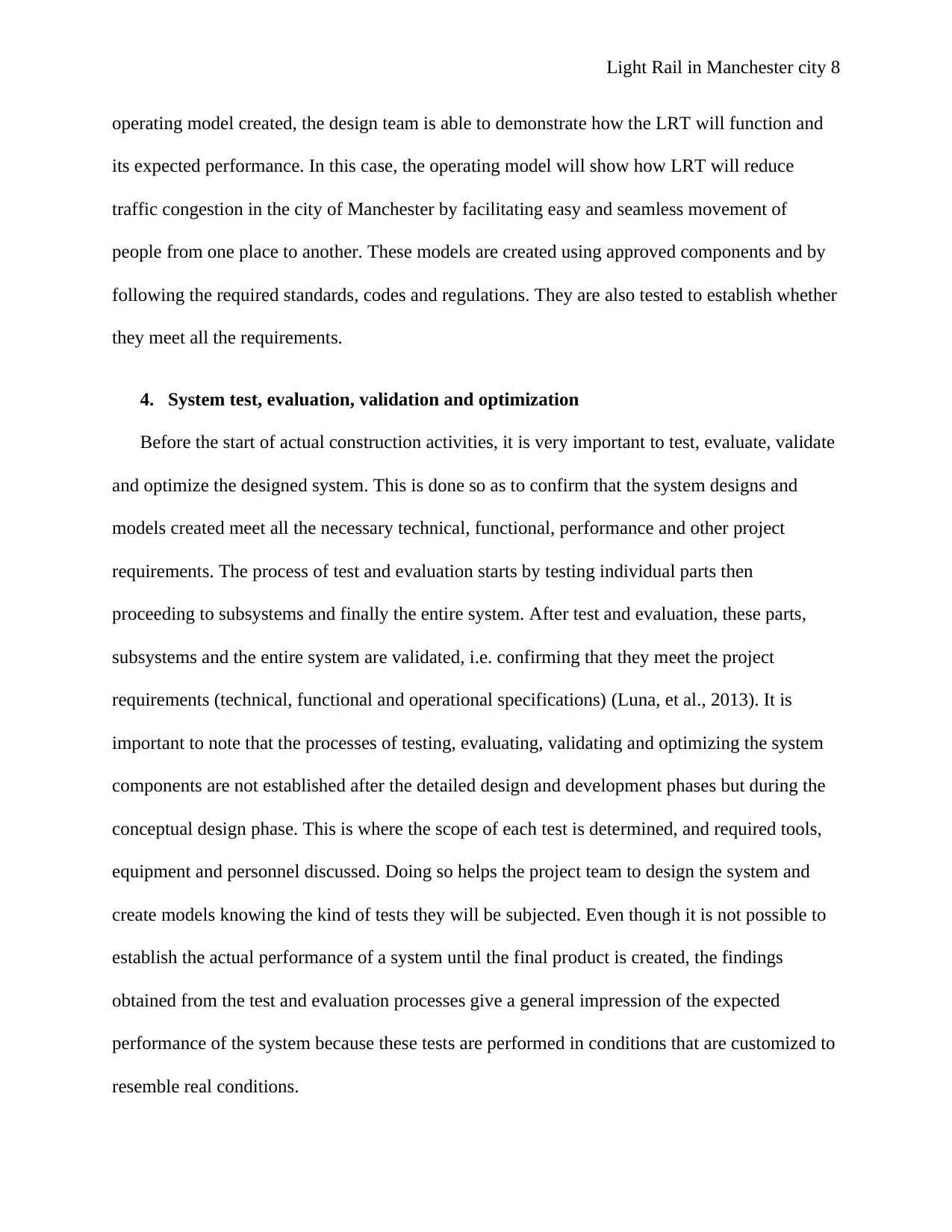
Light Rail in Manchester city 8
operating model created, the design team is able to demonstrate how the LRT will function and
its expected performance. In this case, the operating model will show how LRT will reduce
traffic congestion in the city of Manchester by facilitating easy and seamless movement of
people from one place to another. These models are created using approved components and by
following the required standards, codes and regulations. They are also tested to establish whether
they meet all the requirements.
4. System test, evaluation, validation and optimization
Before the start of actual construction activities, it is very important to test, evaluate, validate
and optimize the designed system. This is done so as to confirm that the system designs and
models created meet all the necessary technical, functional, performance and other project
requirements. The process of test and evaluation starts by testing individual parts then
proceeding to subsystems and finally the entire system. After test and evaluation, these parts,
subsystems and the entire system are validated, i.e. confirming that they meet the project
requirements (technical, functional and operational specifications) (Luna, et al., 2013). It is
important to note that the processes of testing, evaluating, validating and optimizing the system
components are not established after the detailed design and development phases but during the
conceptual design phase. This is where the scope of each test is determined, and required tools,
equipment and personnel discussed. Doing so helps the project team to design the system and
create models knowing the kind of tests they will be subjected. Even though it is not possible to
establish the actual performance of a system until the final product is created, the findings
obtained from the test and evaluation processes give a general impression of the expected
performance of the system because these tests are performed in conditions that are customized to
resemble real conditions.
operating model created, the design team is able to demonstrate how the LRT will function and
its expected performance. In this case, the operating model will show how LRT will reduce
traffic congestion in the city of Manchester by facilitating easy and seamless movement of
people from one place to another. These models are created using approved components and by
following the required standards, codes and regulations. They are also tested to establish whether
they meet all the requirements.
4. System test, evaluation, validation and optimization
Before the start of actual construction activities, it is very important to test, evaluate, validate
and optimize the designed system. This is done so as to confirm that the system designs and
models created meet all the necessary technical, functional, performance and other project
requirements. The process of test and evaluation starts by testing individual parts then
proceeding to subsystems and finally the entire system. After test and evaluation, these parts,
subsystems and the entire system are validated, i.e. confirming that they meet the project
requirements (technical, functional and operational specifications) (Luna, et al., 2013). It is
important to note that the processes of testing, evaluating, validating and optimizing the system
components are not established after the detailed design and development phases but during the
conceptual design phase. This is where the scope of each test is determined, and required tools,
equipment and personnel discussed. Doing so helps the project team to design the system and
create models knowing the kind of tests they will be subjected. Even though it is not possible to
establish the actual performance of a system until the final product is created, the findings
obtained from the test and evaluation processes give a general impression of the expected
performance of the system because these tests are performed in conditions that are customized to
resemble real conditions.
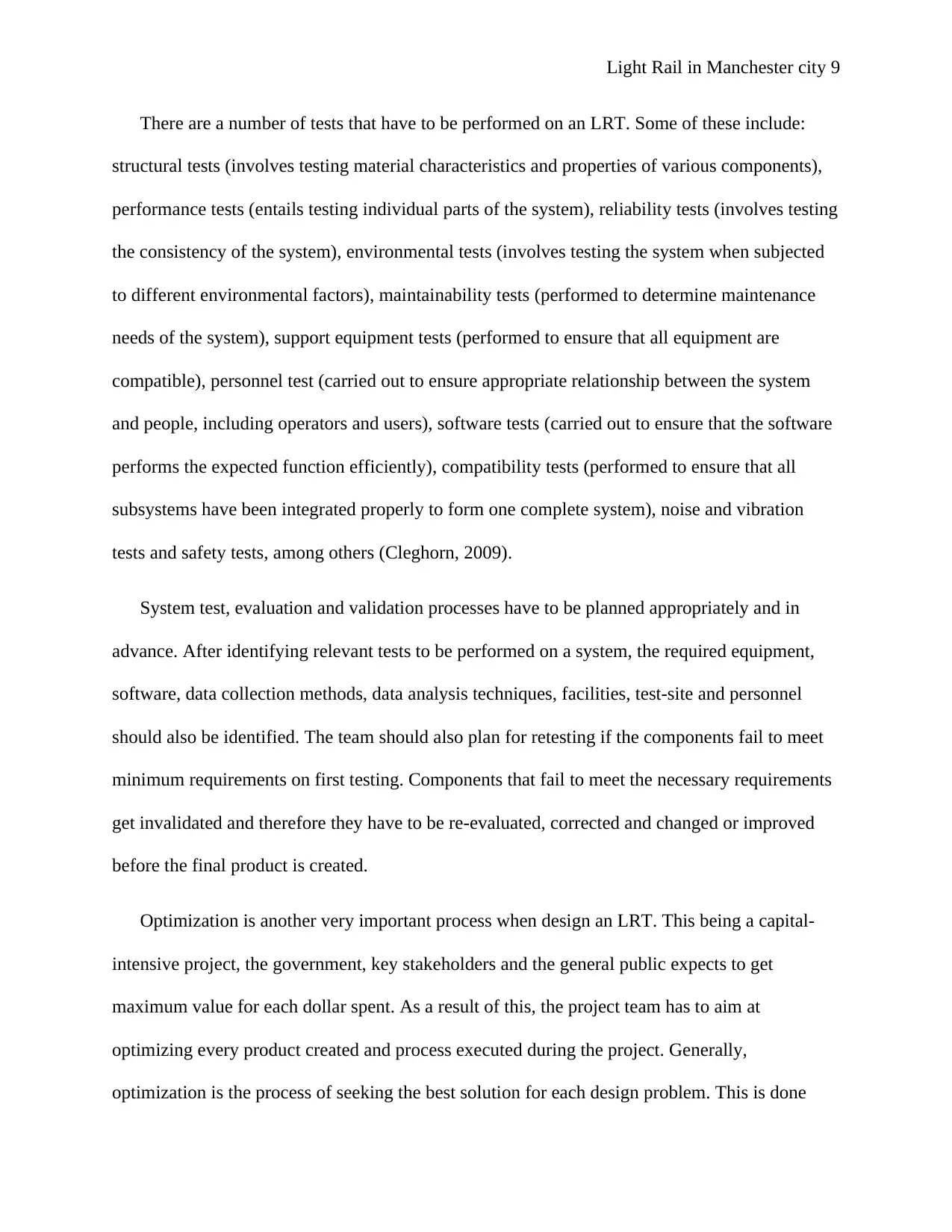
Light Rail in Manchester city 9
There are a number of tests that have to be performed on an LRT. Some of these include:
structural tests (involves testing material characteristics and properties of various components),
performance tests (entails testing individual parts of the system), reliability tests (involves testing
the consistency of the system), environmental tests (involves testing the system when subjected
to different environmental factors), maintainability tests (performed to determine maintenance
needs of the system), support equipment tests (performed to ensure that all equipment are
compatible), personnel test (carried out to ensure appropriate relationship between the system
and people, including operators and users), software tests (carried out to ensure that the software
performs the expected function efficiently), compatibility tests (performed to ensure that all
subsystems have been integrated properly to form one complete system), noise and vibration
tests and safety tests, among others (Cleghorn, 2009).
System test, evaluation and validation processes have to be planned appropriately and in
advance. After identifying relevant tests to be performed on a system, the required equipment,
software, data collection methods, data analysis techniques, facilities, test-site and personnel
should also be identified. The team should also plan for retesting if the components fail to meet
minimum requirements on first testing. Components that fail to meet the necessary requirements
get invalidated and therefore they have to be re-evaluated, corrected and changed or improved
before the final product is created.
Optimization is another very important process when design an LRT. This being a capital-
intensive project, the government, key stakeholders and the general public expects to get
maximum value for each dollar spent. As a result of this, the project team has to aim at
optimizing every product created and process executed during the project. Generally,
optimization is the process of seeking the best solution for each design problem. This is done
There are a number of tests that have to be performed on an LRT. Some of these include:
structural tests (involves testing material characteristics and properties of various components),
performance tests (entails testing individual parts of the system), reliability tests (involves testing
the consistency of the system), environmental tests (involves testing the system when subjected
to different environmental factors), maintainability tests (performed to determine maintenance
needs of the system), support equipment tests (performed to ensure that all equipment are
compatible), personnel test (carried out to ensure appropriate relationship between the system
and people, including operators and users), software tests (carried out to ensure that the software
performs the expected function efficiently), compatibility tests (performed to ensure that all
subsystems have been integrated properly to form one complete system), noise and vibration
tests and safety tests, among others (Cleghorn, 2009).
System test, evaluation and validation processes have to be planned appropriately and in
advance. After identifying relevant tests to be performed on a system, the required equipment,
software, data collection methods, data analysis techniques, facilities, test-site and personnel
should also be identified. The team should also plan for retesting if the components fail to meet
minimum requirements on first testing. Components that fail to meet the necessary requirements
get invalidated and therefore they have to be re-evaluated, corrected and changed or improved
before the final product is created.
Optimization is another very important process when design an LRT. This being a capital-
intensive project, the government, key stakeholders and the general public expects to get
maximum value for each dollar spent. As a result of this, the project team has to aim at
optimizing every product created and process executed during the project. Generally,
optimization is the process of seeking the best solution for each design problem. This is done
⊘ This is a preview!⊘
Do you want full access?
Subscribe today to unlock all pages.

Trusted by 1+ million students worldwide
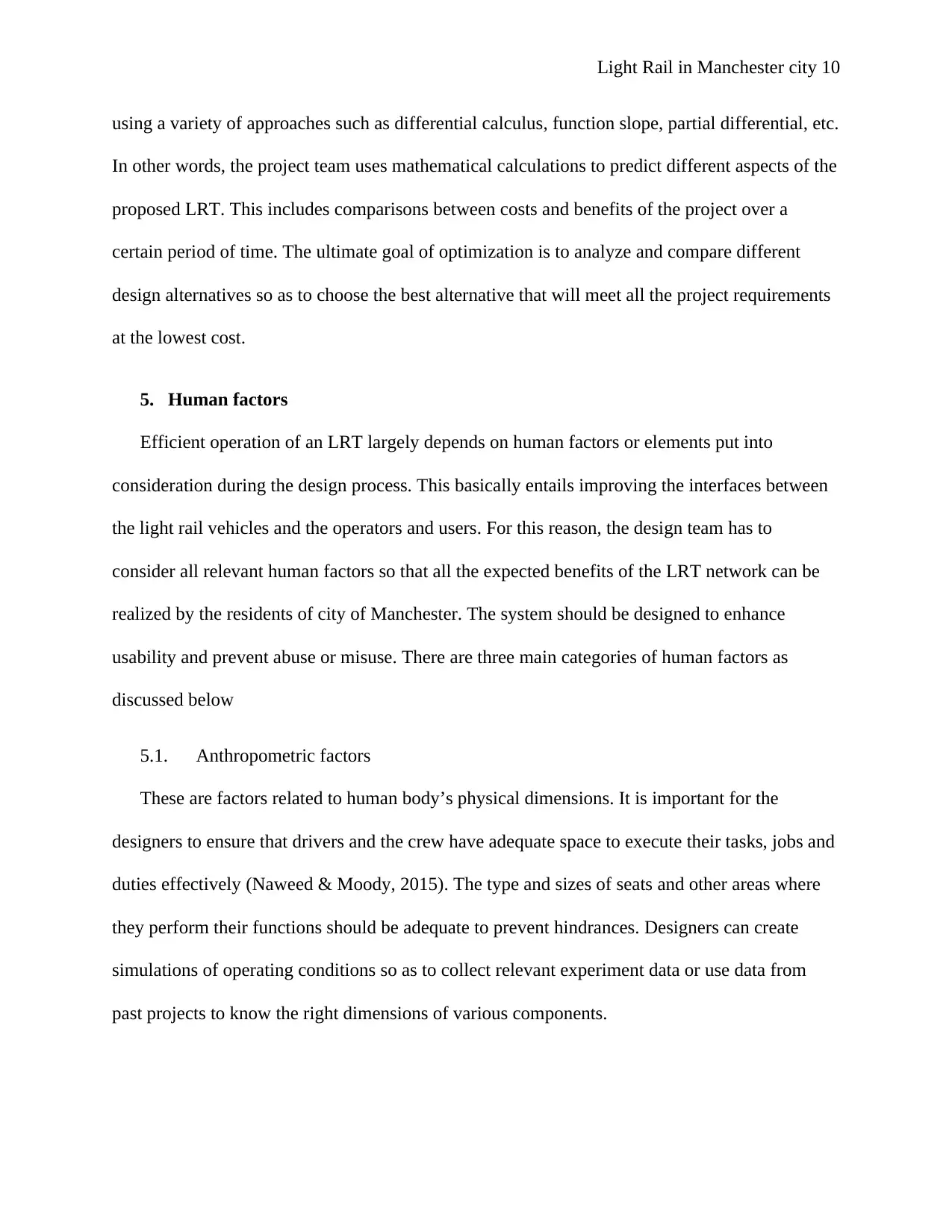
Light Rail in Manchester city 10
using a variety of approaches such as differential calculus, function slope, partial differential, etc.
In other words, the project team uses mathematical calculations to predict different aspects of the
proposed LRT. This includes comparisons between costs and benefits of the project over a
certain period of time. The ultimate goal of optimization is to analyze and compare different
design alternatives so as to choose the best alternative that will meet all the project requirements
at the lowest cost.
5. Human factors
Efficient operation of an LRT largely depends on human factors or elements put into
consideration during the design process. This basically entails improving the interfaces between
the light rail vehicles and the operators and users. For this reason, the design team has to
consider all relevant human factors so that all the expected benefits of the LRT network can be
realized by the residents of city of Manchester. The system should be designed to enhance
usability and prevent abuse or misuse. There are three main categories of human factors as
discussed below
5.1. Anthropometric factors
These are factors related to human body’s physical dimensions. It is important for the
designers to ensure that drivers and the crew have adequate space to execute their tasks, jobs and
duties effectively (Naweed & Moody, 2015). The type and sizes of seats and other areas where
they perform their functions should be adequate to prevent hindrances. Designers can create
simulations of operating conditions so as to collect relevant experiment data or use data from
past projects to know the right dimensions of various components.
using a variety of approaches such as differential calculus, function slope, partial differential, etc.
In other words, the project team uses mathematical calculations to predict different aspects of the
proposed LRT. This includes comparisons between costs and benefits of the project over a
certain period of time. The ultimate goal of optimization is to analyze and compare different
design alternatives so as to choose the best alternative that will meet all the project requirements
at the lowest cost.
5. Human factors
Efficient operation of an LRT largely depends on human factors or elements put into
consideration during the design process. This basically entails improving the interfaces between
the light rail vehicles and the operators and users. For this reason, the design team has to
consider all relevant human factors so that all the expected benefits of the LRT network can be
realized by the residents of city of Manchester. The system should be designed to enhance
usability and prevent abuse or misuse. There are three main categories of human factors as
discussed below
5.1. Anthropometric factors
These are factors related to human body’s physical dimensions. It is important for the
designers to ensure that drivers and the crew have adequate space to execute their tasks, jobs and
duties effectively (Naweed & Moody, 2015). The type and sizes of seats and other areas where
they perform their functions should be adequate to prevent hindrances. Designers can create
simulations of operating conditions so as to collect relevant experiment data or use data from
past projects to know the right dimensions of various components.
Paraphrase This Document
Need a fresh take? Get an instant paraphrase of this document with our AI Paraphraser
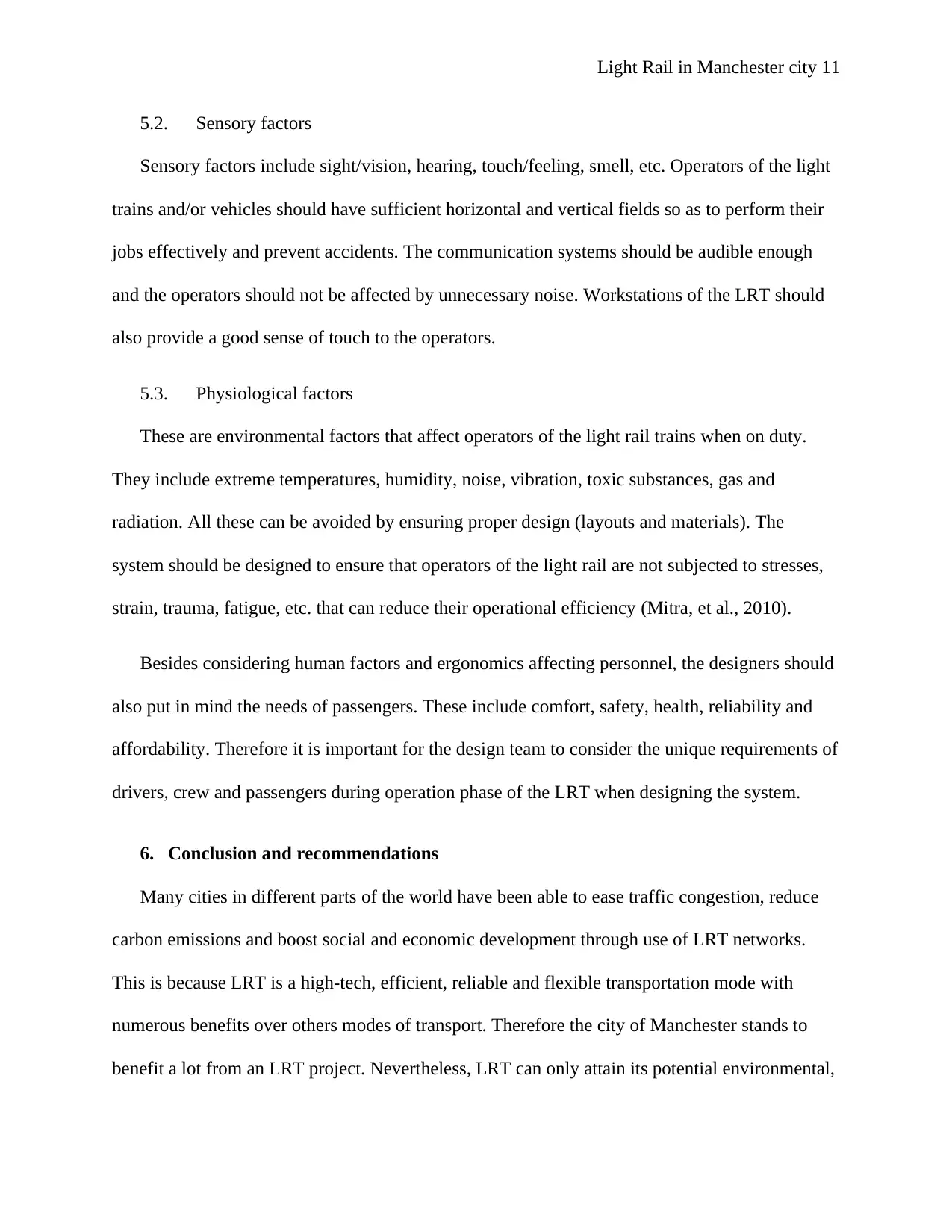
Light Rail in Manchester city 11
5.2. Sensory factors
Sensory factors include sight/vision, hearing, touch/feeling, smell, etc. Operators of the light
trains and/or vehicles should have sufficient horizontal and vertical fields so as to perform their
jobs effectively and prevent accidents. The communication systems should be audible enough
and the operators should not be affected by unnecessary noise. Workstations of the LRT should
also provide a good sense of touch to the operators.
5.3. Physiological factors
These are environmental factors that affect operators of the light rail trains when on duty.
They include extreme temperatures, humidity, noise, vibration, toxic substances, gas and
radiation. All these can be avoided by ensuring proper design (layouts and materials). The
system should be designed to ensure that operators of the light rail are not subjected to stresses,
strain, trauma, fatigue, etc. that can reduce their operational efficiency (Mitra, et al., 2010).
Besides considering human factors and ergonomics affecting personnel, the designers should
also put in mind the needs of passengers. These include comfort, safety, health, reliability and
affordability. Therefore it is important for the design team to consider the unique requirements of
drivers, crew and passengers during operation phase of the LRT when designing the system.
6. Conclusion and recommendations
Many cities in different parts of the world have been able to ease traffic congestion, reduce
carbon emissions and boost social and economic development through use of LRT networks.
This is because LRT is a high-tech, efficient, reliable and flexible transportation mode with
numerous benefits over others modes of transport. Therefore the city of Manchester stands to
benefit a lot from an LRT project. Nevertheless, LRT can only attain its potential environmental,
5.2. Sensory factors
Sensory factors include sight/vision, hearing, touch/feeling, smell, etc. Operators of the light
trains and/or vehicles should have sufficient horizontal and vertical fields so as to perform their
jobs effectively and prevent accidents. The communication systems should be audible enough
and the operators should not be affected by unnecessary noise. Workstations of the LRT should
also provide a good sense of touch to the operators.
5.3. Physiological factors
These are environmental factors that affect operators of the light rail trains when on duty.
They include extreme temperatures, humidity, noise, vibration, toxic substances, gas and
radiation. All these can be avoided by ensuring proper design (layouts and materials). The
system should be designed to ensure that operators of the light rail are not subjected to stresses,
strain, trauma, fatigue, etc. that can reduce their operational efficiency (Mitra, et al., 2010).
Besides considering human factors and ergonomics affecting personnel, the designers should
also put in mind the needs of passengers. These include comfort, safety, health, reliability and
affordability. Therefore it is important for the design team to consider the unique requirements of
drivers, crew and passengers during operation phase of the LRT when designing the system.
6. Conclusion and recommendations
Many cities in different parts of the world have been able to ease traffic congestion, reduce
carbon emissions and boost social and economic development through use of LRT networks.
This is because LRT is a high-tech, efficient, reliable and flexible transportation mode with
numerous benefits over others modes of transport. Therefore the city of Manchester stands to
benefit a lot from an LRT project. Nevertheless, LRT can only attain its potential environmental,
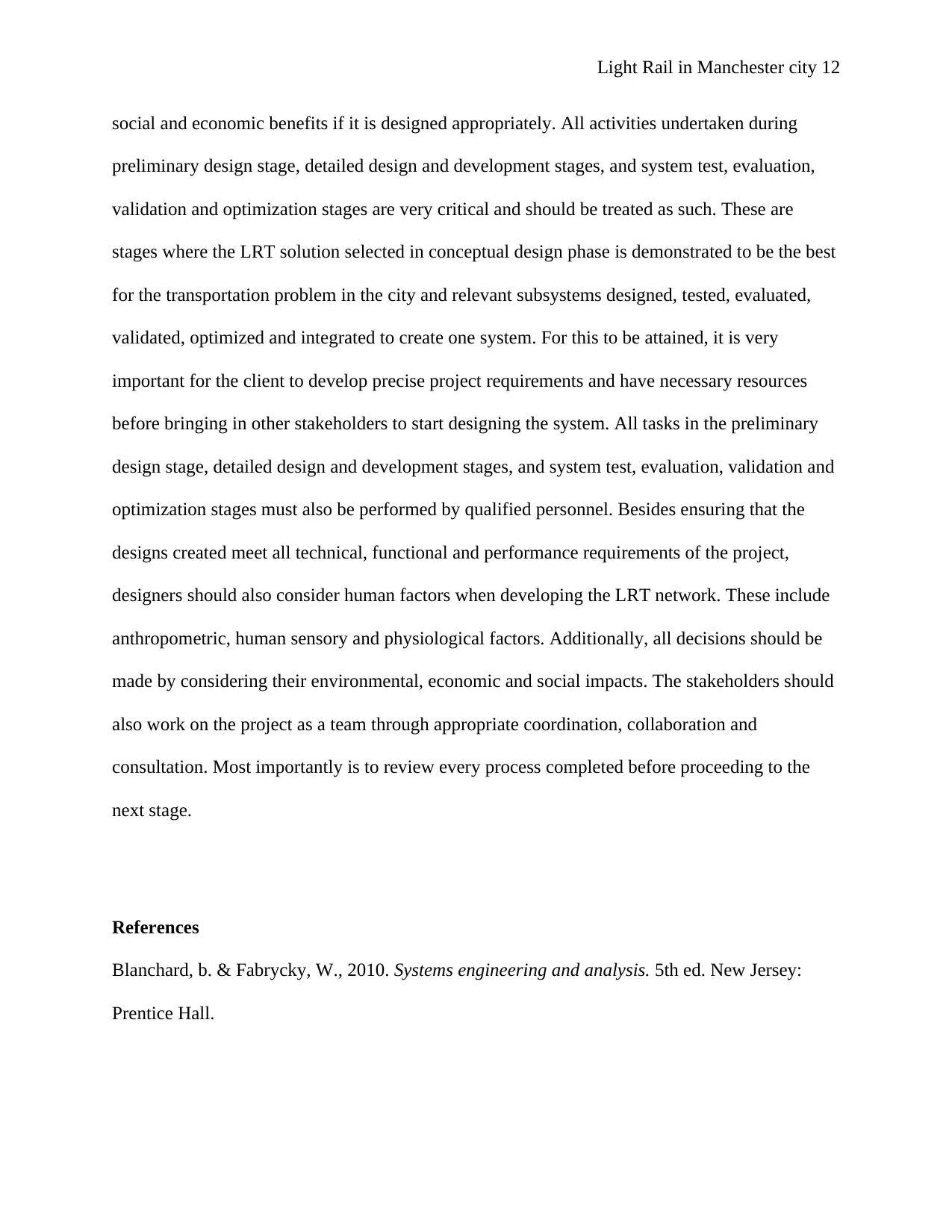
Light Rail in Manchester city 12
social and economic benefits if it is designed appropriately. All activities undertaken during
preliminary design stage, detailed design and development stages, and system test, evaluation,
validation and optimization stages are very critical and should be treated as such. These are
stages where the LRT solution selected in conceptual design phase is demonstrated to be the best
for the transportation problem in the city and relevant subsystems designed, tested, evaluated,
validated, optimized and integrated to create one system. For this to be attained, it is very
important for the client to develop precise project requirements and have necessary resources
before bringing in other stakeholders to start designing the system. All tasks in the preliminary
design stage, detailed design and development stages, and system test, evaluation, validation and
optimization stages must also be performed by qualified personnel. Besides ensuring that the
designs created meet all technical, functional and performance requirements of the project,
designers should also consider human factors when developing the LRT network. These include
anthropometric, human sensory and physiological factors. Additionally, all decisions should be
made by considering their environmental, economic and social impacts. The stakeholders should
also work on the project as a team through appropriate coordination, collaboration and
consultation. Most importantly is to review every process completed before proceeding to the
next stage.
References
Blanchard, b. & Fabrycky, W., 2010. Systems engineering and analysis. 5th ed. New Jersey:
Prentice Hall.
social and economic benefits if it is designed appropriately. All activities undertaken during
preliminary design stage, detailed design and development stages, and system test, evaluation,
validation and optimization stages are very critical and should be treated as such. These are
stages where the LRT solution selected in conceptual design phase is demonstrated to be the best
for the transportation problem in the city and relevant subsystems designed, tested, evaluated,
validated, optimized and integrated to create one system. For this to be attained, it is very
important for the client to develop precise project requirements and have necessary resources
before bringing in other stakeholders to start designing the system. All tasks in the preliminary
design stage, detailed design and development stages, and system test, evaluation, validation and
optimization stages must also be performed by qualified personnel. Besides ensuring that the
designs created meet all technical, functional and performance requirements of the project,
designers should also consider human factors when developing the LRT network. These include
anthropometric, human sensory and physiological factors. Additionally, all decisions should be
made by considering their environmental, economic and social impacts. The stakeholders should
also work on the project as a team through appropriate coordination, collaboration and
consultation. Most importantly is to review every process completed before proceeding to the
next stage.
References
Blanchard, b. & Fabrycky, W., 2010. Systems engineering and analysis. 5th ed. New Jersey:
Prentice Hall.
⊘ This is a preview!⊘
Do you want full access?
Subscribe today to unlock all pages.

Trusted by 1+ million students worldwide
1 out of 14
Related Documents
Your All-in-One AI-Powered Toolkit for Academic Success.
+13062052269
info@desklib.com
Available 24*7 on WhatsApp / Email
![[object Object]](/_next/static/media/star-bottom.7253800d.svg)
Unlock your academic potential
Copyright © 2020–2025 A2Z Services. All Rights Reserved. Developed and managed by ZUCOL.





